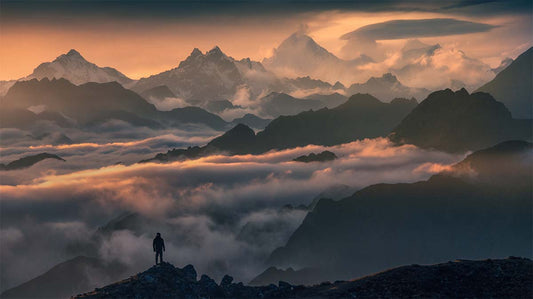The process of selecting your raw photos for editing can be time-consuming, but it doesn’t have to be overwhelming if you work smartly! Have you ever returned from a photography trip with thousands of images, unsure where to start or how to choose the best ones to edit? Maybe you’ve captured multiple shots of the same composition with only slight variations—so how do you decide which one is the one to edit?
Over the years, I have refined a system that makes this process much more efficient. It consists of three key stages: the first happens in the field while shooting, the second takes place in my tent or hotel room later that day, and the final step occurs at home on my laptop when I’m fully ready to edit. By breaking the selection process into these stages, I ensure that only my best work makes it through to post-processing and that I don’t spend hours agonizing over which photos to select.
You might be surprised to learn that, for me, the selection process begins while I’m still shooting. I use the Nikon Z8, which has a feature that allows me to mark favorites. Throughout shooting in the field, I periodically review my images and mark my top picks. Even if your camera does not have a favorite feature you can still record the number of your photo by taking a cellphone pic of your screen of the selected image. This process helps me in two ways:
1. It allows me to analyze my compositions in real time. By checking my images as I shoot, I can determine whether a composition works well or if adjustments are needed. This helps me refine my shots on the spot rather than realizing later that something was off.
2. It keeps me motivated. Knowing that I already have a handful of strong shots encourages me to keep going. By the end of a multi-day shoot, I might already have seven or more photos that I consider portfolio-worthy, which builds excitement for the final editing process.
Step 2: Reviewing in the Hotel or Tent
After shooting, I take time in my hotel room or tent to review all the photos I favorited throughout the day. This is where I make my first round of serious cuts. While an image may have stood out in the moment, looking at it with fresh eyes allows me to assess whether it still holds up. If I notice anything I could have done better, then I will consider revisiting that location to shoot again the following day if time permits. But generally I will look at the favorites and compare the image I favourited to the other images of a similar composition that isn’t in the favourites – just to make sure I’ve chosen the best.
Think of this like shopping for a car—when you first see one you love, you might think, Wow, this is the perfect car! But after a bit of time and reflection, you might start questioning whether it’s really the right choice. The same applies to photo selection. By stepping back for a few hours before reviewing my shots, I gain a more critical perspective, making it easier to refine my selection.
During this stage, I eliminate any photos from my favorites list that no longer seem as strong. If a composition isn’t as powerful as I initially thought, I remove it from my final shortlist. This process ensures that by the time I get home, I am only working with images that have truly made and impression on me.
Step 3: Final Selection at Home
Once I am back home and sitting at my laptop, it’s time for the final round of selection. I take the photos that made it through my previous two rounds and look at them in Photoshop—not to edit them yet, but simply to view them all on a bigger screen and maybe make small adjustments with the highlights and the shadows just to see what’s there. Since I often capture multiple versions of the same composition, this step helps me pinpoint the absolute best version.
At this stage, I focus on technical quality. I check for:
• Sharpness – especially important for focus stacking.
• Exposure – ensuring I have the best balance of light and detail.
• Composition – making sure the shot is as strong as possible.
If two images are nearly identical, I always choose the one with the best technical execution. Even a minor variation in sharpness or exposure can make a big difference when it comes to final edits.
Tips for a Smooth Workflow
Here are a few additional tips to make your photo selection process even easier:
1. Always Start with the Bangers
One of the biggest mistakes photographers make is trying to sift through every single image from the start. This is overwhelming and can lead to decision fatigue. Instead, focus on the images you already know are strong—your bangers. Edit those first, and once they’re done, you can go back and explore the rest. I never plug the hard-drive in and go through the photos one by one, I always refer to my list of per-selected favorites and then I can start editing straight away. It really keeps me motivated tools.
2. Don’t Underestimate Cropping
Sometimes an image that doesn’t immediately stand out can become a winner with the right crop. Pay attention to how different framing choices can improve composition and storytelling.
3. Use Adobe Bridge or Similar Software
While I personally don’t use Adobe Bridge, I’ve heard great things about it. It provides a quick overview of all your photos, allowing for easy comparisons and selections. Using software that simplifies your workflow can save hours of time.
Final Thoughts
By following these steps, you can streamline your post-processing workflow, stay motivated, and ensure you are only editing your very best images. Instead of feeling overwhelmed by thousands of photos, you will have a clear, structured approach to selecting and processing your top shots.
If you need any guidance on editing this post is for you, if you want more detailed editing tutorials you can find them here. Happy editing!
Max Rive is most driven by seeking new perspectives in the natural world and capturing them in his own distinguished style. Max's powerful portrayals of his interactions with the mountains has earned him international recognition in the outdoor community.
Madison McCardle is a passionate landscape photographer driven by curiosity and a desire to capture the true essence of each place she explores. Through her lens, she seeks new perspectives that reveal the beauty and authenticity of the world.
✉️ JOIN US TODAY
Don't miss out on wallpapers, E-books and tour announcements!
RELATED ARTICLES
DISCUSSION
LEAVE A COMMENT
Your Email Address Will Not Be Published. Required Fields Are Marked *






























No comments